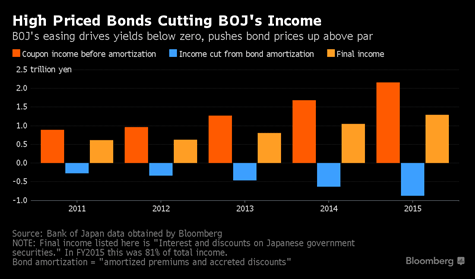I keep trying to keep my eyes off the market so I can work on this new project. It’s usually the best thing to do in weeks like this. Stick to your plan. Manage your risk. Don’t panic. Ignore the hype.
But Japan. Japan! It continues to baffle and amaze. Remember Monday when I told you that 80% of Japanese government bonds had negative yields? That number is now 85%. It’s like some kind of wealth-destroying feedback loop that can’t be stopped.
How weird is it?
The 10-year note had a yield of negative 0.24% on Wednesday. The 20-year bond fell to a yield of just 0.04%. The 30-year yield fell to 0.05%. And the yield on Japan’s 40-year bond is just 0.065%.
If you’re not buying Japanese bonds, and if you’re not a Japanese saver – which you’re probably not, given that this is a UK-based publication for UK-savers and investors – then you might wonder why Japan’s very strange market matters at all. It’s a fair question.
The answer is simple: Japan is the prototype for central bank responses to deflation. What happens in Japan first usually happens in other places later. When yields go negative, and when it begins distorting the entire financial system, it pays to pay attention.
What does not pay right now is buying government bonds. The Bank of Japan (BoJ) itself – the largest holder of government bonds – wrote down about $8 billion worth of its government bond holdings in 2015. That’s what happens when you hold a negative yielding security to maturity.

The bank is still generating some income on its portfolio, mostly because it has so many bonds. But you can see from the chart above that as the bank slowly writes down the value of its bonds, it eats into the final income it generates. If rates go lower and stay lower, the final income figure will go lower too.
It could even go negative
“If the amortization losses from the BOJ’s bond buying operations become too large, it’s possible that income could go negative”, said former BoJ deputy governor Kazumasa Iwata in April. And what about the risk to the bank’s capital and solvency? As I mentioned on Monday, longer-term bond prices fall more than shorter-term bond prices when interest rates rise. Could the bank’s capital be wiped out by a surge in interest rates?
Well, a fuller discussion of whether central banks can go bankrupt is beyond the scope of today’s short note. Suffice it to say that former Fed chair Ben Bernanke said “no” in a speech on just this subject years ago. He reckons Japan’s Ministry of Finance, for example, could just fire up the printing press if it had to.
But that certainly wouldn’t be a good look. It’s why – one way or another – we are nearing the endgame of this experiment. The bond monster keeps devouring yields everywhere. Bloomberg reports that yield-starved Japanese savers are searching for it in US Treasuries now. That drives prices up even more and yields lower in the US.
Japan isn’t Switzerland
The entire government bond market has negative yields there. Japan is headed that way. And if the US moves in that direction – simply because of global capital fleeing into US bonds – well there’s no telling how high gold go in that case.
Trust in the entire banking system would plummet. Gold and cash would benefit (as long as cash is still legal to possess and does not have an expiration date). It’s an unbearable position for savers.
“Everything is becoming expensive for Japanese investors, leaving them with no yield, only risk,” says Shuichi Ohsaki, at Bank of America Merrill Lynch. “The possibility that yields on everything including the 40-year bond will drop into negative territory is undeniable.”
She is undeniably right. How do you manage risk when your only option – if you want income – is to take it by lending to a heavily-indebted government for 40-years with a meagre yield? It’s almost as if governments don’t care about debtors more than savers. Hmm. But there is hope! More on that tomorrow.

Category: Geopolitics

